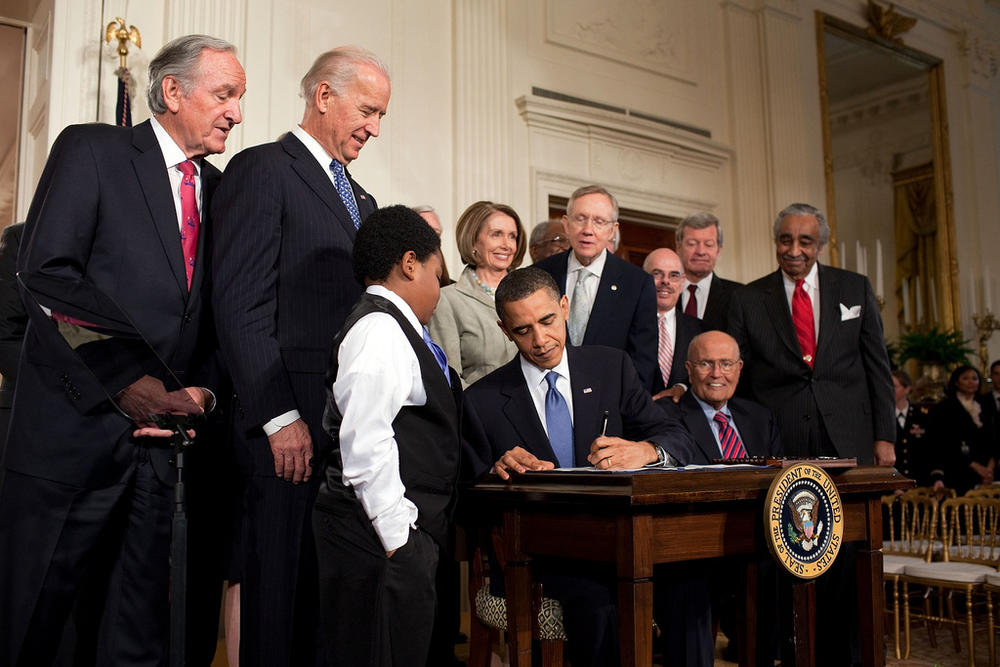
Section Branding
Header Content
Medicaid Coverage Gap: Nothing Sweet About This Doughnut Hole For The Working Poor
Primary Content

The goal of ACA (Affordable Care Act) is that EVERYONE have health insurance coverage. There are different routes for obtaining coverage: through your job; through the online ACA Marketplace; through Medicare for those 65 and older; through Medicaid (and Medicaid expansion) for the poor.
The president has acknowledged the disastrous debut of www.HealthCare.gov, the marketplace’s website, due to glitches and deficiencies in website design, and promised needed fixes to enable ease of enrollment.

President Obama signing the Patient Protection and Affordable Care Act on March 23, 2010. Courtesy, Wikimedia
Medicaid has historically covered low income children; seniors; people with disabilities; and pregnant women. However, for the most part, adults without dependent children have not been covered under Medicaid. One of the ACA pivotal provisions for covering low income families was expanding Medicaid coverage to also include non-disabled adults with incomes up through 138% of the federal poverty level. The federal poverty line is drawn at incomes of $11,170 for an individual, $19,000 for a family of three, $23,550 for a family of four. Under ACA, the federal government would fully finance all additional costs of this Medicaid expansion for the first 3 years (2014-2016), then phase down to 90% by 2020. Expanding Medicaid to 138% of the federal poverty level ($27,000 for a family of three) would extend coverage nationally to 17 million previously uninsured adults.
Universal coverage for this subset of working poor fell apart with the June 2012 Supreme Court decision making this Medicaid expansion optional for states. As of September 2013, 26 states (including Georgia) had opted out of expanding Medicaid. On October 21, 2013, Ohio switched gears and opted in for the expansion, making it the 25th state (as well Washington, D.C.) to expand Medicaid coverage. New Hampshire legislature voted yesterday (November 14, 2013) to expand Medicaid in their state as well.
In states that opt out, those adversely affected and thus left out are the working poor: they make too much to qualify for Medicaid, but not enough to qualify to buy health insurance through the Marketplace. ACA does not provide tax credits toward insurance premiums for those with incomes below poverty level. Those living in states that opt out of Medicaid expansion, and have incomes greater than 100% of the federal poverty level may be eligible for subsidies through the Marketplaces.
Kaiser Commission data say that of the states opting out of the ACA Medicaid expansion, only Wisconsin provides Medicaid coverage to adults who don’t have dependent children. Regarding Georgia, this commission says only parents of dependent children with incomes of 39% of the federal poverty level -- $7,589 for a family of three -- will be eligible for coverage. No other non-disabled adults will be covered.
Five million working poor adults fall into this coverage gap doughnut hole. Eight per cent -- more than 400,000 adults -- of those left out live in Georgia.
This ACA Facts series helps explain important details of the Affordable Care Act.
Part 1: Ready, Set, Insure: ACA Health Insurance Marketplaces are Open for Business
Part 2: The New Healthcare Equation for Insurance Coverage
Part 3: The New ACA Insurance Marketplace: Who needs to shop?
If you have a particular question you would like answered, send your request to
AskDrSandy@gpb.org.





